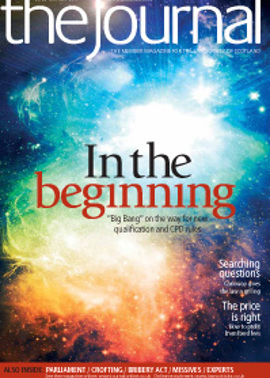Book reviews

Elaine E Sutherland, Kay E Goodall, Gavin F M Little and Fraser P Davidson (ed)
PUBLISHER: EDINBURGH UNIVERSITY PRESS
ISBN: 978 0 748640195
PRICE: £60
On 12 May 1999, Dr Winnie Ewing at the opening of the Scottish Parliament stated: “The Scottish Parliament, which was adjourned on 25 March 1707, is hereby reconvened”.
This collection of essays critically analyses “the first 10 years of law making by the Scottish Parliament”. The areas addressed and considered are diverse and wide ranging. The editors have gathered essays from a number of Scotland’s leading academic and practising lawyers in public, criminal, family, property and environment law.
Standing their socio-legal effect, the areas of criminal justice, human rights and the judiciary within the post-devolution constitutional settlement of Scotland are particularly considered here.
In her well observed essay, Professor Pamela Ferguson records that the Parliament has enacted 147 statutes of which over a third are related to criminal procedure, sentencing, and the creation of substantive criminal law, creating over 400 new offences, in areas as diverse as sexual crimes (35 offences), sunbed operators, and even ploughing. Ferguson concludes that there has been an unwelcome ad hoc approach to law making in the area of criminal justice and calls for codification of criminal law, echoing the view of Professor Eric Clive. A similar conclusion, that law making has been “piecemeal and fragmented”, is offered by the authors of the chapters on education, the environment and housing.
Within this section of the collection, Professor Little offers a rigorous analysis of the significant reform of the Scottish judiciary with its maintenance and reinforcement of judicial independence, subject of course to the new powers of inquiry into judicial conduct and behaviour vested in the Lord President. Little offers the view that as the (mis)conduct of the judiciary is overseen by the judiciary itself, it reinforces judicial independence as free from executive interference, although some have questioned whether that function itself is a potential constraint on the exercise of judicial independence (contrast Aidan O’Neill’s view that one benefit of the opportunity to appeal to the Supreme Court is that that very possibility is a means to keep judges and practitioners “sharp” and “more careful in how and what they decide”).
O’Neill offers a searing critique of what he regards as a legislative deficit through the absence of any committee or the Parliament itself to hold the executive to account on the human rights compatibility of legislation, especially when Alan Page offers the view that the legislative programme is more executive-led than was anticipated. O’Neill observes the absence of public law human rights challenges due to the civil law requirement of title and interest (D & J Nicol v Dundee Harbour Trustees 1915 SC (HL) 12), commenting on the impact of Lord Gill’s review and its aspiration on class actions. O’Neill concludes that the Supreme Court’s appellate jurisdiction provides a more pervasive “benefit” than that offered by the Strasbourg and Luxembourg jurisprudence, but acknowledges that this view is not universally shared by the Scottish judiciary.
O’Neill’s suggestion that the role of the Lord Advocate has been traduced to that of a Scottish DPP is somewhat undermined by Page’s considered analysis in his crafted overview of the legislative process. Within that process the Lord Advocate must provide a statement that proposed legislation is within devolved legislative competence, and is a member of the cabinet subcommittee on legislation which is “at the heart of the government’s legislative machinery”.
This is a thoroughly considered, approachable book from which practitioners of every discipline will find something of interest, upon which they will be able to reflect but, perhaps most importantly, will find a resonance whether it be the background to a piece of legislation (why was change necessary), the mechanism by which legislation is developed through to enactment (how we ended up with what we work with), or putting the legislation or policy reform in its policy or socio-legal context. Anyone who wants to know how the new Scottish Parliament creates legislation and the effect it has had (and may yet have) on the Scottish legal landscape need look no further than this illuminating set of essays.
Rarely can it be said that a book not only ought to be on the bookshelf of every lawyer interested and concerned in the development of law but ought to be read and savoured. This is such a book.
David J Dickson, Solicitor Advocate
Cybercrimes: A Multidiscipliary Analysis
Sumit Ghosh and Elliot Turrini (eds)
PUBLISHER: SPRINGER
ISBN: 978 3 642135460
PRICE: £126
This book wants you to take cybercrime seriously. Very seriously indeed. In chapter 1 the sub-chapters are given aggressive headings such as “the battle to control the computing process”; “the nature of the battle”; “the Cyberbattlefield”; “the attacker’s tools”; “the defender’s tools”; and so on. You’d be forgiven for thinking you were reading a book about the terrifying future of warfare, not the future of crime.
However, if the reader can summon the courage to progress from the smoke and wreckage of chapter 1, there’s plenty of interesting information to be found. The chapters have been authored by various writers and co-edited by Professor Sumit Ghosh (chair of the computer science department at the University of Texas) and Elliot Turrini (assistant US Attorney for the District of New Jersey, where he is responsible for various high-tech and intellectual property prosecutions).
Although the book is presented as a reference work for practitioners, academics and scholars worldwide, I would agree with the authors’ assertion that it is written to appeal to a much wider audience. Some content is great and really accessible.
The chapter on the formidable challenges posed by cybercrimes is thought-provoking, the condensed history of the development of malicious code is informative, and the summary of the international dimensions of cybercrime is also very engaging.
Other chapters are inevitably less useful. Personally I found the discussion of the psyche of cybercriminals to be fairly irrelevant, while 20 pages speculating on “the nature of cyberattacks in the future” is intellectually amusing, but probably inappropriate in a reference work.
For the practitioner, and especially the practitioner in Scotland, the book is realistically going to be of very limited usefulness. The authors are prone to the occasional flights of fancy that are beloved of the academic but frowned upon by the paying client. A monitoring tool is ridiculously likened to the tech spec of the death star embedded in R2D2 in Star Wars; the phrase “cyber-punk” is deployed without any apparent recognition of just how silly it sounds; and the plot of Bruce Willis’s Live Free and Die Hard is offered up as an example of the kind of rampant cybercrime that really could happen in the imminent future. There is a single paragraph on “licenses [sic] and legal agreements”, a brisk treatment of “content protection efforts”, and a summary of civil and criminal penalties which is concentrated on US law.
This isn’t to say that I would recommend against practitioners reading this book. On the contrary, I think it will provide any reader a greater understanding of the world we now live in, and many will enjoy it a lot more than they expect at the outset.
John D McGonagle, Senior Solicitor, Brodies LLP, Edinburgh
THE BOUNDRIES OF THE CRIMINAL LAW
R A Duff, Lindsay Farmer, S E Marshall, Massimo Renzo and Victor Tadros
PUBLISHER: OXFORD UNIVERSITY PRESS
ISBN: 978 0 199600557
PRICE: £50
It has been common in recent years to hear claims that the United Kingdom faces a crisis of “overcriminalisation”; that governments are addicted to creating vast swathes of new criminal offences. No one quite knows how many criminal offences actually exist, but Tony Blair’s New Labour Government was established to have created almost one new offence for every day in office, ranging from the delightfully obscure (disturbing a pack of eggs when instructed not to by an authorised officer) to the positively frightening (creating a nuclear explosion). How people slept soundly prior to the reassurance of the Nuclear Explosions (Prohibition and Inspections) Act 1998 remains something of a mystery.
While various Government departments (the worst offender, perhaps surprisingly, seems to have been the Department for Environment, Food and Rural Affairs) have been busy expanding the boundaries of the criminal law, the Government has been generous enough (through the Arts and Humanities Research Council) to offer a group of academics funding to study the phenomenon of criminalisation. This book, a collection of essays by leading scholars, is the first fruit of that project, and is to be followed, remarkably, by a further half-dozen books in future years.
This volume contains 10 essays, including an introduction by the editors. Doing it justice would take an essay in itself, but they explore the theory of what it is that justifies resort to criminal law in particular. What does it mean for something to be marked out as a public wrong by the criminal law, and how is such wrongness to be identified? And how does the overuse of the criminal law, particularly the creation of offences which the state lacks the resources to prosecute or punish, affect the discretionary decisions of those who actually have to operate the law in practice?
Overcriminalisation, as Duff’s discussion of “subversions of criminal law” explains, is not the full story. Paradoxically, at the same time as enormously expanding the scope of the criminal law, New Labour was remarkably keen on subverting it. Criminal law is designed to safeguard liberty in a way that civil law does not, imposing requirements such as a higher standard of proof and stricter rules of evidence. These are inconvenient, and devices such as the ASBO are designed to avoid them, by allowing resort to the civil in place of the criminal courts. Here, as the essay by Ashworth and Zedner explains, we have a problem of under-criminalisation: the protections established in the criminal process are circumvented.
So in sum: too much criminal law, and too little. Seven books are unlikely to solve the problem, but they should at least help us to understand it better.
Dr James Chalmers, University of Edinburgh
In this issue
- Experience not to be missed
- Call in the experts
- Planning to deliver
- Stars of the future
- Registered Paralegal Scheme hits the mark
- CPD: a personal quest
- Wha's like us?
- Holyrood: a verdict
- Public ethos
- Power in name only?
- From the Brussels office
- Minority voices
- Law reform update
- Quinn Direct - when to intimate?
- Name your price
- Ask Ash
- Communication breakdown - a major risk issue
- Interested parties
- Support from afar
- Plus ça change?
- Where the state has to stop
- A NEST egg?
- Scottish Solicitors' Discipline Tribunal
- Website review
- Book reviews
- Above board
- Ruaig an Fhèidh
- The price of breach






